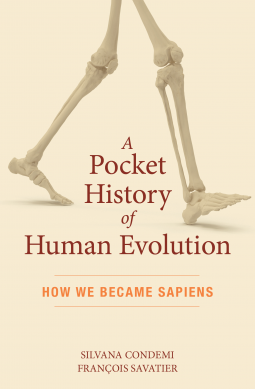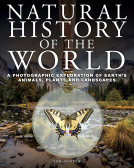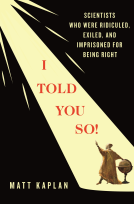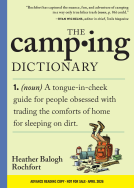
A Pocket History of Human Evolution
How We Became Sapiens
by Silvana Condemi; François Savatier
This title was previously available on NetGalley and is now archived.
Send NetGalley books directly to your Kindle or Kindle app
1
To read on a Kindle or Kindle app, please add kindle@netgalley.com as an approved email address to receive files in your Amazon account. Click here for step-by-step instructions.
2
Also find your Kindle email address within your Amazon account, and enter it here.
Pub Date Nov 01 2019 | Archive Date Nov 15 2019
Talking about this book? Use #ApocketHistoryOfHumanEvolution #NetGalley. More hashtag tips!
Description
This file is NOT currently available for Kindle. We apologize for any inconvenience. If you have difficulties with downloading, please email us (at publicity@theexperimentpublishing.com) for assistance or leave a note in lieu of a review rating.
Why aren’t we more like other apes? How did we win the evolutionary race? Find out how “wise” Homo sapiens really are.
Prehistory has never been more exciting: New discoveries are overturning long-held theories left and right. Stone tools in Australia date back 65,000 years—a time when, we once thought, the first Sapiens had barely left Africa. DNA sequencing has unearthed a new hominid group—the Denisovans—and confirmed that crossbreeding with them (and Neanderthals) made Homo sapiens who we are today.
A Pocket History of Human Evolution brings us up-to-date on the exploits of all our ancient relatives. Paleoanthropologist Silvana Condemi and science journalist François Savatier consider what accelerated our evolution: Was it tools, our “large” brains, language, empathy, or something else entirely? And why are we the sole surviviors among many early bipedal humans? Their conclusions reveal the various ways ancient humans live on today—from gossip as modern “grooming” to our gendered division of labor—and what the future might hold for our strange and unique species.
Available Editions
| EDITION | Other Format |
| ISBN | 9781615196043 |
| PRICE | $14.95 (USD) |
| PAGES | 160 |
Links
Average rating from 11 members
Featured Reviews
 Anika P, Reviewer
Anika P, Reviewer
This book is very helpful as an "update" for a reader who hasn't studied prehistory in some time! The authors, a paleoanthropologist and a science journalist, make a solid attempt at answering the questions that come out of scientific findings. The future of humankind is addressed.
Crisp overview of human evolution
I enjoyed this book. There are a lot of good books out there that go into a lot of detail about human evolution, but what’s nice about this book is that it is reads crisply and it’s written in a conversational tone. As a pocket guide, it can’t go into all the details, but it gives a great overview and has many clarifying illustrations. Kudos to Thomas Haessig for the illustrations. The translation of the book was seamless, so kudos to Emma Ramadan. I strongly recommend this book for anyone interested in human evolution.
There are many secrets that lie in our history. Studying our roots is definitive way to trace from where we came and to guess where we are going.
This is a small book which tries to convey our evolution, moulding, selection and impact.
Book has simple and little technical language and guiding pictures to show in time lapse what sapiens did.
It focuses on main events and changes which fartured simple monkey to the top of the food chain.
How we migrated, developed tools, tribes, communication, killed so many, developed arts and how we reached here.
Everything is explained based on scientific research and archaeology and genetics.
It is information filled, entertaining book which helps reader to gain insights into complexity of life which is being rapidly disrupted by man.
It is amazing to read about interesting fossils and to see them on Google. A very immersive way to read and discover while reading.
Last chapter focuses on ecological disruption by humans and it is the most important lesson to be learned from this true story.
Afterall we didn't adapt, evolve and struggle; to destroy our own adobe at last.
Thanks netgalley and publisher for the review copy.
 Evelina A, Reviewer
Evelina A, Reviewer
This is a short, but incredibly informative book about the evolution and history of man. It was very good, easily readable and incredibly interesting. I absolutely loved it.
The book starts with how primates slowly turned into humans and what were the stepping stones - which behaviors pushed us to turn into what we are now, and finishes with the migration and dispersion of Sapiens throughout the world, as well as the direction we are moving now (biological vs social and cultural evolution). It talks in short about all the human subspecies before us and what was different about them. The book contains a lot of very interesting facts - such as why humans are born so relatively helpless - our brains and skulls are much too huge to be able to pass through the birth canal as complete as those of other animals, so human babies have to finish maturing after they're born instead of before. There are many such seemingly little details that made us who we are in the span of millions of years. This book really gives you the feeling of respect for the human body - because it explains how many things had to change and adapt to enable us to survive. We are often taught that the human is nothing compared to an animal - we're frail, puny, weak. But it's not quite like that - we're also economical energetically, cunning and able to form a social structure that nurtures us like no other species in the world.
I was particularly happy to read about how important the domestication of the wolf (dog) has been to us as a species. The dog had so many jobs to do in human society, and not just early society - jobs that dogs still do in our society even now (rescuers, guides, hunting partners, finders, peace keepers and more). The love for dogs is programmed deep into the minds of a lot of us.
I also really loved the charts in this book - there are many. Some have timelines, branches of species and there are even brain size charts for some of the subspecies. I was most fascinated with the charts that detailed how Sapiens (essentially, us) mixed with Neanderthals and other human species to make us who we are right now.
I thank the publisher for giving me a free copy of the ebook in exchange to my honest review. This has not affected my opinion.
 Teri P, Librarian
Teri P, Librarian
A Pocket History of Human Evolution is a quick update on history and new discoveries in anthropology. This well written and easily accessible book took me back to my undergraduate anthropology class. This was an accessible read that I thoroughly enjoyed.
**I received an ARC from NetGalley for a fair and unbiased review of this book.
Readers who liked this book also liked:
Mart Kuldkepp
History, Nonfiction (Adult), Politics & Current Affairs
Antony Johnston
General Fiction (Adult), Mystery & Thrillers, New Adult


















